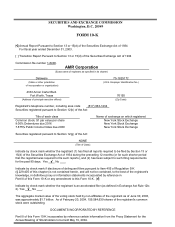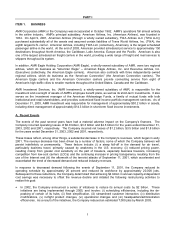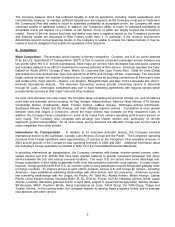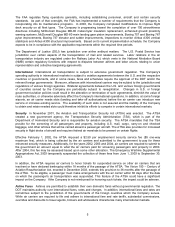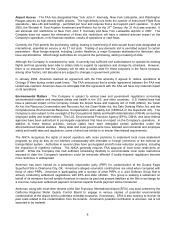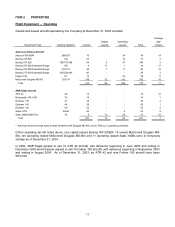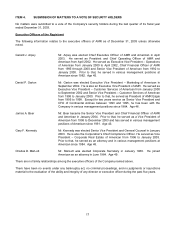American Airlines 2003 Annual Report Download - page 9
Download and view the complete annual report
Please find page 9 of the 2003 American Airlines annual report below. You can navigate through the pages in the report by either clicking on the pages listed below, or by using the keyword search tool below to find specific information within the annual report.
7
Miami-Dade County (the County) is currently investigating and remediating various environmental conditions at the
Miami International Airport (MIA) and funding the remediation costs through landing fees and various cost recovery
methods. American and AMR Eagle have been named PRPs for the contamination at MIA. During the second
quarter of 2001, the County filed a lawsuit against 17 defendants, including American, in an attempt to recover its
past and future cleanup costs (Miami-Dade County, Florida v. Advance Cargo Services, Inc., et al. in the Florida
Circuit Court). In addition to the 17 defendants named in the lawsuit, 243 other agencies and companies were also
named as PRPs and contributors to the contamination. American’s and AMR Eagle’s portion of the cleanup costs
cannot be reasonably estimated due to various factors, including the unknown extent of the remedial actions that
may be required, the proportion of the cost that will ultimately be recovered from the responsible parties, and
uncertainties regarding the environmental agencies that will ultimately supervise the remedial activities and the
nature of that supervision. The Company is vigorously defending the lawsuit.
In 1999, American was ordered by the New York State Department of Environmental Conservation (NYSDEC) to
conduct remediation of environmental contamination located at Terminals 8 and 9 at New York’s John F. Kennedy
International Airport (JFK). American is seeking to recover a portion of the remediation costs from previous users
of the Terminals 8 and 9 premises. In 2002, American began negotiating an order with NYSDEC for the
remediation of a JFK off-terminal hangar facility. American does not expect the costs associated with this
remediation to be material.
In 1996, American and Executive, along with other tenants at the Luis Munoz Marin International Airport in San
Juan, Puerto Rico were notified by the Port Authority that it considered them potentially responsible for
environmental contamination at the airport. In 2003, the Port Authority requested that American, among other
airport tenants, fund an ongoing subsurface investigation and site assessment. American denied liability for the
related costs. No further action has been taken against American or Executive.
American Eagle Airlines, Inc. has been notified of its potential liability under New York law at an inactive hazardous
waste site in Poughkeepsie, New York. Pursuant to an Administrative Order on Consent entered into with
NYSDEC, American Eagle is implementing a final remedy to address contamination at the site. The costs of this
final remedy are not material.
The Company does not expect these matters, individually or collectively, to have a material impact on its financial
condition, results of operations or cash flows.
D. Labor
The airline business is labor intensive. Wages, salaries and benefits represented approximately 40 percent of the
Company’s consolidated operating expenses for the year ended December 31, 2003. The average equivalent
number of employees of the Company’s subsidiaries for the year ended December 31, 2003 was 96,400.
The majority of these employees are represented by labor unions and covered by collective bargaining
agreements. Relations with such labor organizations are governed by the Railway Labor Act. Under this act, the
collective bargaining agreements among the Company’s subsidiaries and these organizations generally do not
expire but instead become amendable as of a stated date. If either party wishes to modify the terms of any such
agreement, it must notify the other party in the manner described in the agreement. After receipt of such notice,
the parties must meet for direct negotiations, and if no agreement is reached, either party may request the National
Mediation Board (NMB) to appoint a federal mediator. If no agreement is reached in mediation, the NMB may
declare at some time that an impasse exists, and if an impasse is declared, the NMB proffers binding arbitration to
the parties. Either party may decline to submit to arbitration. If arbitration is rejected by either party, a 30-day
“cooling off” period commences. During that period (or after), a Presidential Emergency Board (PEB) may be
established, which examines the parties’ positions and recommends a solution. The PEB process lasts for 30
days and is followed by a “cooling off” period of 30 days. At the end of a “cooling off” period, unless an agreement
is reached or action is taken by Congress, the labor organization may strike and the airline may resort to “self-
help”, including the imposition of any or all of its proposed amendments and the hiring of new employees to replace
the striking workers.


